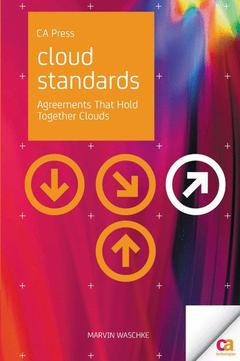Description
Cloud Standards, 1st ed.
Agreements That Hold Together Clouds
Author: Waschke Marvin
Language: English
Approximative price 52.74 €
In Print (Delivery period: 15 days).
Add to cart360 p. · 15.2x22.9 cm · Paperback
Description
/li>Contents
/li>Biography
/li>Comment
/li>
Cloud Standards is a broad discussion of important existing and future standards. For existing standards, the discussion focuses on how they are used, providing practical advice to engineers constructing clouds and services to be deployed on clouds. For future standards, the discussion is on why a standard is needed, what the benefits will be, and what is being done now to fill the gap. No current book provides this information in the depth and detail necessary for an engineer in his work, an architect in designing cloud systems, a product manager collecting and evaluating products, or an executive evaluating the feasibility of a project. A second benefit from this book is that it provides insight into cloud implementations. Cloud implementations can be seen as the culmination of many trends in software and hardware engineering. Much of the foundation for these developments have been crystallized in the form of standards like TCP/IP (Transmission Control Protocol/Internet Protocol) and HTTP (Hypertext Transmission Protocol). The book leads readers to understand how these contribute to and affect cloud implementations.
Unfortunately, emerging standards are often messy. Cloud implementers may need to choose between competing proposed standards. Sometimes it is better to reject the standard entirely and "roll your own." This book provides background for intelligent decisions.
Keeping a cloud, or an application implemented on a cloud, running well requires careful tuning of the implementation. Tuning often involves adjusting controls that are in the standard or applying the standard in less well-known ways. This book is an aid in tuning cloud systems for maximum benefits.
- Setting the Scene, Some Cloud Scenarios
- What are Standards? Why do they exist?
- What is cloud?
- Cloud Related Technologies and Services
- Types of standards that go into the cloud and how they interact
- Network Standards
- Internet Standards
- Web Services Standards
- Security Standards
- Cloud Specific Standards (This chapter will be long. Break it up?-marv)
- Management Standards and Best Practices
- Summing Up
Cloud Standards is a discussion of important existing and future standards.
For existing standards, the emphasis is on how they are used and practical advice to engineers constructing clouds and cloud-based services.
For future standards, the book focuses on why a standard is needed, what the benefits will be, and what is being done now to fill the gap.
These books may interest you

Essentials of Cloud Computing 160.25 €



